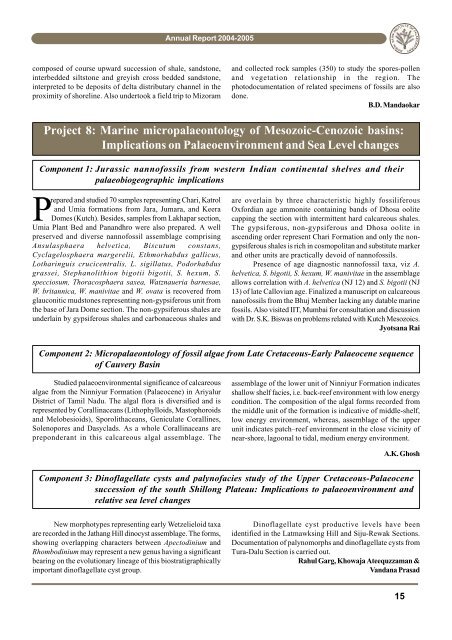english final - Birbal Sahni Institute of Palaeobotany
english final - Birbal Sahni Institute of Palaeobotany
english final - Birbal Sahni Institute of Palaeobotany
Create successful ePaper yourself
Turn your PDF publications into a flip-book with our unique Google optimized e-Paper software.
BIRBAL SAHNI INSTITUTE OF PALAEOBOTANY<br />
Annual Report 2004-2005<br />
composed <strong>of</strong> course upward succession <strong>of</strong> shale, sandstone,<br />
interbedded siltstone and greyish cross bedded sandstone,<br />
interpreted to be deposits <strong>of</strong> delta distributary channel in the<br />
proximity <strong>of</strong> shoreline. Also undertook a field trip to Mizoram<br />
and collected rock samples (350) to study the spores-pollen<br />
and vegetation relationship in the region. The<br />
photodocumentation <strong>of</strong> related specimens <strong>of</strong> fossils are also<br />
done.<br />
B.D. Mandaokar<br />
Project 8: Marine micropalaeontology <strong>of</strong> Mesozoic-Cenozoic basins:<br />
Implications on Palaeoenvironment and Sea Level changes<br />
Component 1: Jurassic nann<strong>of</strong>ossils from western Indian continental shelves and their<br />
palaeobiogeographic implications<br />
Prepared and studied 70 samples representing Chari, Katrol<br />
and Umia formations from Jara, Jumara, and Keera<br />
Domes (Kutch). Besides, samples from Lakhapar section,<br />
Umia Plant Bed and Panandhro were also prepared. A well<br />
preserved and diverse nann<strong>of</strong>ossil assemblage comprising<br />
Ansulasphaera helvetica, Biscutum constans,<br />
Cyclagelosphaera margerelii, Ethmorhabdus gallicus,<br />
Lotharinguis crucicentralis, L. sigillatus, Podorhabdus<br />
grassei, Stephanolithion bigotii bigotii, S. hexum, S.<br />
specciosum, Thoracosphaera saxea, Watznaueria barnesae,<br />
W. britannica, W. manivitae and W. ovata is recovered from<br />
glauconitic mudstones representing non-gypsiferous unit from<br />
the base <strong>of</strong> Jara Dome section. The non-gypsiferous shales are<br />
underlain by gypsiferous shales and carbonaceous shales and<br />
are overlain by three characteristic highly fossiliferous<br />
Oxfordian age ammonite containing bands <strong>of</strong> Dhosa oolite<br />
capping the section with intermittent hard calcareous shales.<br />
The gypsiferous, non-gypsiferous and Dhosa oolite in<br />
ascending order represent Chari Formation and only the nongypsiferous<br />
shales is rich in cosmopolitan and substitute marker<br />
and other units are practically devoid <strong>of</strong> nann<strong>of</strong>ossils.<br />
Presence <strong>of</strong> age diagnostic nann<strong>of</strong>ossil taxa, viz A.<br />
helvetica, S. bigotii, S. hexum, W. manivitae in the assemblage<br />
allows correlation with A. helvetica (NJ 12) and S. bigotii (NJ<br />
13) <strong>of</strong> late Callovian age. Finalized a manuscript on calcareous<br />
nan<strong>of</strong>ossils from the Bhuj Member lacking any datable marine<br />
fossils. Also visited IIT, Mumbai for consultation and discussion<br />
with Dr. S.K. Biswas on problems related with Kutch Mesozoics.<br />
Jyotsana Rai<br />
Component 2: Micropalaeontology <strong>of</strong> fossil algae from Late Cretaceous-Early Palaeocene sequence<br />
<strong>of</strong> Cauvery Basin<br />
Studied palaeoenvironmental significance <strong>of</strong> calcareous<br />
algae from the Ninniyur Formation (Palaeocene) in Ariyalur<br />
District <strong>of</strong> Tamil Nadu. The algal flora is diversified and is<br />
represented by Corallinaceans (Lithophylloids, Mastophoroids<br />
and Melobesioids), Sporolithaceans, Geniculate Corallines,<br />
Solenopores and Dasyclads. As a whole Corallinaceans are<br />
preponderant in this calcareous algal assemblage. The<br />
assemblage <strong>of</strong> the lower unit <strong>of</strong> Ninniyur Formation indicates<br />
shallow shelf facies, i.e. back-reef environment with low energy<br />
condition. The composition <strong>of</strong> the algal forms recorded from<br />
the middle unit <strong>of</strong> the formation is indicative <strong>of</strong> middle-shelf,<br />
low energy environment, whereas, assemblage <strong>of</strong> the upper<br />
unit indicates patch–reef environment in the close vicinity <strong>of</strong><br />
near-shore, lagoonal to tidal, medium energy environment.<br />
A.K. Ghosh<br />
Component 3: Din<strong>of</strong>lagellate cysts and palyn<strong>of</strong>acies study <strong>of</strong> the Upper Cretaceous-Palaeocene<br />
succession <strong>of</strong> the south Shillong Plateau: Implications to palaeoenvironment and<br />
relative sea level changes<br />
New morphotypes representing early Wetzelieloid taxa<br />
are recorded in the Jathang Hill dinocyst assemblage. The forms,<br />
showing overlapping characters between Apectodinium and<br />
Rhombodinium may represent a new genus having a significant<br />
bearing on the evolutionary lineage <strong>of</strong> this biostratigraphically<br />
important din<strong>of</strong>lagellate cyst group.<br />
Din<strong>of</strong>lagellate cyst productive levels have been<br />
identified in the Latmawksing Hill and Siju-Rewak Sections.<br />
Documentation <strong>of</strong> palynomorphs and din<strong>of</strong>lagellate cysts from<br />
Tura-Dalu Section is carried out.<br />
Rahul Garg, Khowaja Ateequzzaman &<br />
Vandana Prasad<br />
15

















